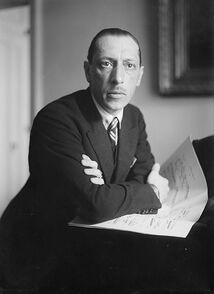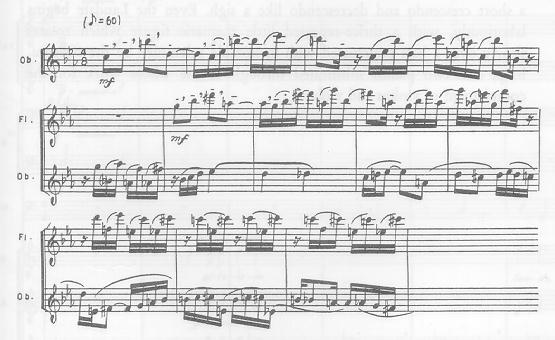|
WORLD PREMIERE:
Dec. 13, 1930 Societe Philharmonique de Bruxelles Ernst Ansermet, conductor |
US PREMIERE:
Dec. 19, 1930 Boston Symphony Orchestra Cecilia Society Chorus Serge Koussevitzky, conductor |
OVERVIEW and INFO: en.wikipedia.org/wiki/Symphony_of_Psalms
Excellent site!! Provides history, analysis, discussion of each of the
three movements, musical examples
ALSO: some good info at this site
(site has very small print---you might need to enlarge the page)
www.cco.caltech.edu/~tan/Stravinsky/sop.html
Excellent site!! Provides history, analysis, discussion of each of the
three movements, musical examples
ALSO: some good info at this site
(site has very small print---you might need to enlarge the page)
www.cco.caltech.edu/~tan/Stravinsky/sop.html
The work's three movements are performed without a break, and the texts sung by the chorus are drawn from the Vulgate versions in Latin. Unlike many pieces composed for chorus and orchestra,
Stravinsky said that “it is not a symphony in which I have included Psalms to be sung.
On the contrary, it is the singing of the Psalms that I am symphonizing."
Stravinsky portrays the religious nature of the text through his compositional techniques. He wrote substantial portions of the piece in fugal counterpoint, which was used widely in the church in the Renaissance and Baroque periods. He also uses the large chorus to create a ritual atmosphere
like that of the Church.
Stravinsky said that “it is not a symphony in which I have included Psalms to be sung.
On the contrary, it is the singing of the Psalms that I am symphonizing."
Stravinsky portrays the religious nature of the text through his compositional techniques. He wrote substantial portions of the piece in fugal counterpoint, which was used widely in the church in the Renaissance and Baroque periods. He also uses the large chorus to create a ritual atmosphere
like that of the Church.
FORM - MOVEMENT 1
The first movement serves as a Prelude to the Double Fugue of the second movement. It begins with arabesque appregios in the woodwind punctuated with several chords of E minor. The strings enter and pass the theme to the altos.
The choir sings "Exaudi orationem meam Domine" on two adjacent notes, resembling a fervent prayer.
The woodwind accompanies with an ostinato bass in 4-note cells, consisting of the pair of rising minor thirds, B-D A-C#.
The motif with which the woodwind accompanies the vocal line is the basis for the later movements;
we find it in the first subject of the Fugue (movement #2) and in the thematic design of the last movement.
The altos' minor second theme takes turns with the full chorus to bring the music, with staccato woodwind and brass accompaniment, to the climax with "Ne sileas." The transitions are marked by the E minor chord that accompanied the opening.
Further development of the minor second figure brings the theme to the tenors and then to the trebles, after which there is a climax with the modulation into a major key.
The first movement serves as a Prelude to the Double Fugue of the second movement. It begins with arabesque appregios in the woodwind punctuated with several chords of E minor. The strings enter and pass the theme to the altos.
The choir sings "Exaudi orationem meam Domine" on two adjacent notes, resembling a fervent prayer.
The woodwind accompanies with an ostinato bass in 4-note cells, consisting of the pair of rising minor thirds, B-D A-C#.
The motif with which the woodwind accompanies the vocal line is the basis for the later movements;
we find it in the first subject of the Fugue (movement #2) and in the thematic design of the last movement.
The altos' minor second theme takes turns with the full chorus to bring the music, with staccato woodwind and brass accompaniment, to the climax with "Ne sileas." The transitions are marked by the E minor chord that accompanied the opening.
Further development of the minor second figure brings the theme to the tenors and then to the trebles, after which there is a climax with the modulation into a major key.
|
FORM - MOVEMENT 2
The second movement is a Double Fugue in C minor for voices and instruments. The theme of the Instrumental Fugue (Fugal Subject #1) is based on the same 4-note cell used in Movement 1. It is stated by the oboe and is then taken up by the flute. Oboes and flute then also play the first development of the Fugue, in a soft organ-like register. |
|
The Vocal Fugue (Fugal Subject #2) is stated by the trebles, contraltos, tenors, and basses; then a stretto Expectans expectavi Dominum from the second Fugue leads into a passage for choir a cappella, which is followed by the stretto from the first Fugue, by the orchestra alone.
The `act of hope', "Et immisit in os meum canticum novum," is stated by full choir and orchestra is followed by a sudden hush with "Et sperabunt in Domino" in unison leading to a final "Alleluia" going into the third movement (a sort of Hymn of Praise on the text of Psalm 150.) |
FORM - MOVEMENT 3
The third movement of the Symphony of Psalms alternates "Tempo = 48" and "Tempo = 80", and uses nearly the complete text of Psalm 150.
Stravinsky wrote: The allegro in Psalm 150 was inspired by a vision of Elijah's chariot climbing the Heavens; never before had I written anything quite so literal as the triplets for horns and piano to suggest the horses and chariot.
The third movement of the Symphony of Psalms alternates "Tempo = 48" and "Tempo = 80", and uses nearly the complete text of Psalm 150.
Stravinsky wrote: The allegro in Psalm 150 was inspired by a vision of Elijah's chariot climbing the Heavens; never before had I written anything quite so literal as the triplets for horns and piano to suggest the horses and chariot.
Stravinsky continues by saying: The final hymn of praise must be thought of as issuing from the skies; agitation is followed by the calm of praise. In setting the words of this final hymn I cared only for the sounds of the syllables and I have indulged to the limit my besetting pleasure of regulating prosody in my own way.
COMPLETE WORK with SCROLLING FULL SCORE:
Orchestra: Chicago Symphony Orchestra
Conductor: Sir Georg Solti
NOTE: Click on "SEE MORE" in the video to view tabs for start of each movement, plus excellent notes.
NOTE:
00:00 - 1st movement
03:24 - 2nd movement
10:07 - 3rd movement
Orchestra: Chicago Symphony Orchestra
Conductor: Sir Georg Solti
NOTE: Click on "SEE MORE" in the video to view tabs for start of each movement, plus excellent notes.
NOTE:
00:00 - 1st movement
03:24 - 2nd movement
10:07 - 3rd movement




